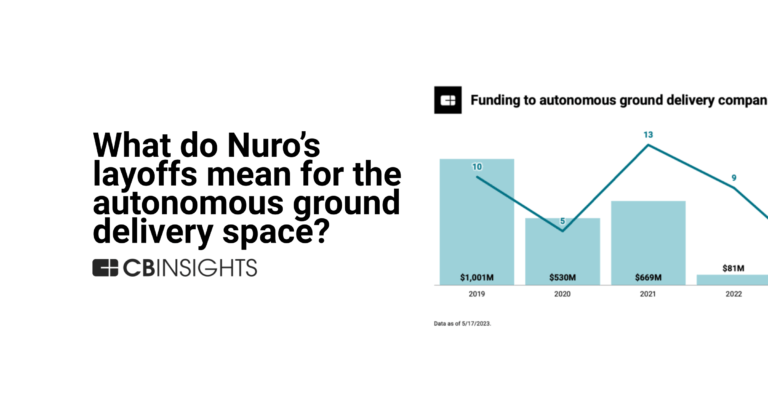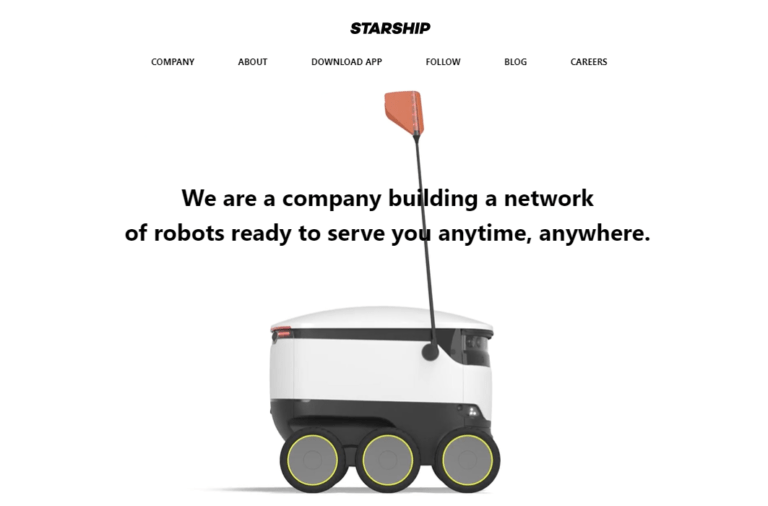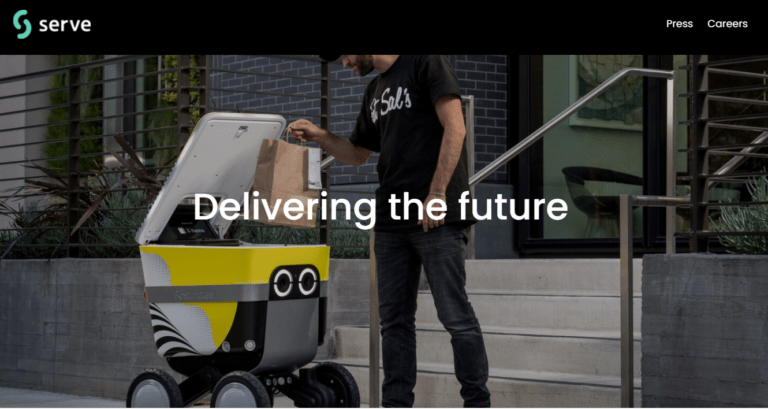
Starship
Founded Year
2014Stage
Series C | AliveTotal Raised
$287.56MLast Raised
$90M | 9 mos agoMosaic Score The Mosaic Score is an algorithm that measures the overall financial health and market potential of private companies.
+196 points in the past 30 days
About Starship
Starship Technologies specializes in autonomous robot delivery within the delivery industry. The company offers solutions for food and package deliveries using self-driving robots designed to improve efficiency and sustainability. Starship's robots are utilized across various settings, including towns, cities, and campuses, to provide a convenient delivery experience. It was founded in 2014 and is based in San Francisco, California.
Loading...
Starship's Product Videos
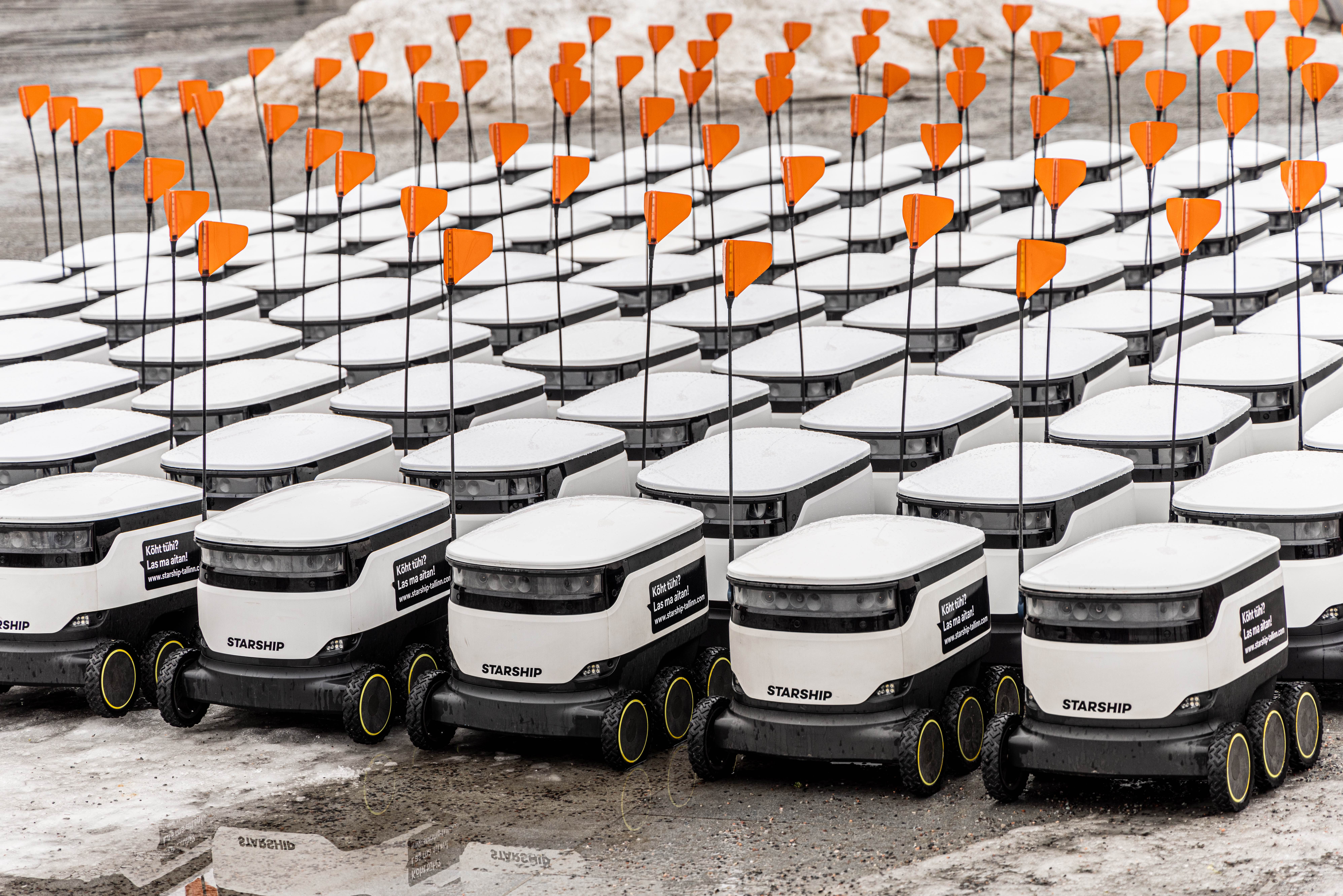
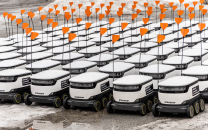
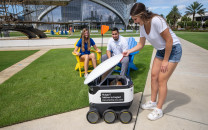
ESPs containing Starship
The ESP matrix leverages data and analyst insight to identify and rank leading companies in a given technology landscape.
The autonomous ground delivery market is automating the last-mile delivery of goods. It involves the use of self-driving vehicles and robots to deliver packages and cargo, reducing the need for human drivers and increasing efficiency. The market includes various technologies such as automated driving systems, delivery robots, and sidewalk robots. Many of the vehicles are purpose-built for logistic…
Starship named as Leader among 11 other companies, including Nuro, Serve Robotics, and Cartken.
Starship's Products & Differentiators
Autonomous Robot
A robot that travels on sidewalks, crosses roads and delivers food, groceries etc.
Loading...
Research containing Starship
Get data-driven expert analysis from the CB Insights Intelligence Unit.
CB Insights Intelligence Analysts have mentioned Starship in 3 CB Insights research briefs, most recently on May 23, 2023.
Expert Collections containing Starship
Expert Collections are analyst-curated lists that highlight the companies you need to know in the most important technology spaces.
Starship is included in 9 Expert Collections, including Auto Tech.
Auto Tech
2,183 items
Companies working on automotive technology, which includes vehicle connectivity, autonomous driving technology, and electric vehicle technology. This includes EV manufacturers, autonomous driving developers, and companies supporting the rise of the software-defined vehicles.
Supply Chain & Logistics Tech
6,169 items
Companies offering technology-driven solutions that serve the supply chain & logistics space (e.g. shipping, inventory mgmt, last mile, trucking).
Robotics
2,006 items
This collection includes startups developing autonomous ground robots, unmanned aerial vehicles, robotic arms, and underwater drones, among other robotic systems. This collection also includes companies developing operating systems and vision modules for robots.
Grocery Retail Tech
648 items
Startups providing B2B solutions to grocery businesses to improve their store and omni-channel performance. Includes customer analytics platforms, in-store robots, predictive inventory management systems, online enablement for grocers and consumables retailers, and more.
Retail Tech 100
100 items
The most promising B2B tech startups transforming the retail industry.
Advanced Manufacturing
6,362 items
Companies in the advanced manufacturing tech space, including companies focusing on technologies across R&D, mass production, or sustainability
Starship Patents
Starship has filed 87 patents.
The 3 most popular patent topics include:
- robotics
- robots
- differential wheeled robots

Application Date | Grant Date | Title | Related Topics | Status |
|---|---|---|---|---|
10/14/2019 | 9/17/2024 | Robotics, Robots, Stimulants, Artificial intelligence, Robot architectures | Grant |
Application Date | 10/14/2019 |
|---|---|
Grant Date | 9/17/2024 |
Title | |
Related Topics | Robotics, Robots, Stimulants, Artificial intelligence, Robot architectures |
Status | Grant |
Latest Starship News
Nov 6, 2024
The jaws of the launch pad caught the hovering space rocket This is a key maneuver for the future success of the world’s largest rocket. TEXAS. The American aircraft carrier SpaceX successfully carried out an unprecedented maneuver on Sunday afternoon. As part of the fifth test flight of the world’s largest Starship rocket, the machine landed vertically directly on the launch pad. Specifically, it was the first stage of the rocket nicknamed Super Heavy. The ramp caught the rocket as it floated through the air. The article continues under the advertising video The article continues under the advertising video No one has so far attempted a similar maneuver, which is why it was associated with a high degree of risk that serious damage would occur to the ground infrastructure of the Starbase space complex on the coast of the US state of Texas. The mission was also accomplished by the second stage, the Starship spacecraft , which landed vertically in the Indian Ocean. SpaceX broadcast the 65-minute test mission live via the X social network. From the recording you can also watch the entire flight, which started at 2.25pm CET. You will read: because SpaceX believed it would not destroy its launch complex, why it is so important that the spaceship “learns” to land on the launch pad. A delicacy for enthusiasts Starship is a two-stage rocket with double the performance of the legendary Saturn V from the days of the Apollo space program. The lower part, the Super Heavy rocket launcher, has 33 Raptor engines, measures 71 meters and has a diameter of nine meters. The upper stage, the Starship spacecraft, has six Raptor engines and measures 50 meters. SpaceX engineers are making progress with the Starship rocket. During the test on June 4, it was possible to land vertically on the water surface with both parts of the innovative machine. As part of today’s effort, they wanted to raise the bar again. Much of the attention was therefore focused on the Super Heavy missile carrier. The latter, after separating from the Starship, turned around and headed back towards the coast of Texas. The main plan was for it to return to the launch pad, where it would be intercepted by the launch tower’s large mechanical jaws designed specifically for this maneuver. However, first it was necessary to verify that the machine and the ramp itself were technically perfect. Even before the rocket temporarily shut down its engines, its flight director had to send a manual command to land on the ramp. Since both the tower and engine worked well, SpaceX abandoned Plan B, which called for a soft landing on the surface of the Gulf of Mexico. During landing, the Super Heavy first ignited 13 of the 33 engines, then only three remained. The path of a successful vertical landing directly on the launch pad in Texas: The machine approached the tall tower slowly, but at a relatively large inclination, and very gently entered its jaws. They believed each other However, during flights to and from space, failure should always be expected. Even more so when it comes to testing previously unexplored techniques and mechanisms. However, SpaceX believed that the chances of successfully capturing the rocket from the air were high. The aforementioned June landing in the Gulf of Mexico proved to be excellent. News from space this week cited Bill Gerstenmaier, SpaceX’s vice president of flight reliability, said the super-heavy carrier landed with an accuracy of half a centimeter: “So we think we have a reasonable chance of getting back on the ramp.” The outer ring of the Super Heavy aircraft carrier’s engines were fished out of the Gulf of Mexico after a successful landing in June. (source: SpaceX, Elon Musk) The technical capabilities of the Super Heavy aircraft carrier also worked in SpaceX’s favor. Unlike the much smaller Falcon 9 rocket, with which the company has already performed hundreds of successful flights, including vertical landings, the Super Heavy has a key advantage. He can literally hover above the ground, which allows him to make small adjustments as he tries to get into the right position to be caught by the jaws of the launch turret. The Falcon 9 would not be able to do this, because even the lowest power of just one of its nine engines is forced: the machine would start climbing again. Therefore, a maneuver known as “suicide burn” occurs. Once the engines are started, there is no turning back and the machine must reach zero speed at the exact moment of contact with the landing surface. Super Heavy has a very important margin in this sense. However, if the maneuver was unsuccessful, it was assumed that the damage to infrastructure would not be catastrophic. The Super Heavy had only a minimal mixture of fuel in its tanks and the company is also building a completely new launch pad, the construction of which is already at an advanced stage. Starship didn’t disappoint either As engineers and spaceflight enthusiasts watched the events in Texas, the Starship spacecraft meanwhile continued on a trajectory similar to its June flight. It reached near-orbital velocity and then re-entered the atmosphere to attempt a soft landing on the surface of the Indian Ocean after less than a flyby of Earth. Thanks to the Starlink satellite internet (also from SpaceX’s portfolio), viewers were able to observe virtually the entire reentry process, although the ship was surrounded by hot plasma. This time too, damage to one of the aerodynamic flaps, which helps maintain control over the trajectory of the car, was noticed. However, the trail was nowhere near as wild as in June, when the flaps almost completely disintegrated. The machine’s heat shield withstood another test, and the spacecraft landed on the surface at its intended landing site. It subsequently rolled over on its side and exploded, which, however, was predicted in advance. He wants to match the planes Mastering a vertical landing directly on the launch pad is critical for SpaceX. Not only will the Super Heavy aircraft carrier return from space flights in this way, but also the Starship rocket itself. These are operational and economic reasons. Currently, Falcon 9 rockets land mostly on autonomous landing pads in the ocean, hundreds of kilometers from the launch pad. It takes several days to transport the rocket to the port. Catching rockets directly on the ramp would allow a significant acceleration in preparing the machines for the next flight. The costs of operating landing platforms and escort fleets would be saved, and rockets would not be exposed to the harmful effects of salty seawater. SpaceX’s ultimate goal is to be able to fly the Starship rocket multiple times a day, similar to commercial airplanes. This would open up new opportunities in the form of missile transportation of passengers around the world. At the same time, it would make it possible to realize the vision of the head of SpaceX Elon Musk that the spaceship will regularly fly to Mars, where it will help build a human colony. Universe
Starship Frequently Asked Questions (FAQ)
When was Starship founded?
Starship was founded in 2014.
Where is Starship's headquarters?
Starship's headquarters is located at 535 Mission Street, San Francisco.
What is Starship's latest funding round?
Starship's latest funding round is Series C.
How much did Starship raise?
Starship raised a total of $287.56M.
Who are the investors of Starship?
Investors of Starship include Iconical, Plural, TDK Ventures, Goodyear Ventures, Wise and 21 more.
Who are Starship's competitors?
Competitors of Starship include Cartken, 42dot, Neolix, Nuro, Elroy Air and 7 more.
What products does Starship offer?
Starship's products include Autonomous Robot.
Who are Starship's customers?
Customers of Starship include Tesco and Co-op.
Loading...
Compare Starship to Competitors

Nuro specializes in autonomous vehicle technology within the robotics and local commerce domains. The company designs and deploys custom electric autonomous vehicles for local delivery services, aiming to provide a convenient and environmentally friendly alternative to traditional transportation methods. Its autonomous delivery vehicles serve various sectors, including retail and healthcare, by delivering goods such as produce and prescriptions directly to consumers. The company was founded in 2016 and is based in Mountain View, California.
Udelv is a company that focuses on the autonomous vehicle industry, specifically in the domain of last-mile and middle-mile deliveries. The company's main product is a driverless, multi-stop delivery electric vehicle (EV) designed for these delivery routes. This EV is engineered as a turnkey driverless delivery system, with features such as autonomous functionality, fleet management software, and a mobile experience that facilitates the loading and unloading of goods. Udelv primarily serves sectors that require delivery services, such as ecommerce and logistics. It was founded in 2016 and is based in Burlingame, California.

Neolix provides technological services for the autonomous vehicle industry. It engages in the development and commercial deployment of autonomous vehicles, with a focus on creating smart city logistics infrastructure. Its vehicles are used in a variety of applications and sectors, including logistics and retail. The company was founded in 2018 and is based in Beijing, China.

Matternet specializes in the development and operation of autonomous drone networks for package delivery within the healthcare and commerce sectors. The company offers ultra-fast, low-cost, and zero-emission delivery services using drones that are FAA Type Certified. Matternet's technology is designed to transform logistics in developed economies and provide technological solutions for new economies. It was founded in 2011 and is based in Mountain View, California.

Zipline specializes in autonomous delivery systems and instant logistics within the drone delivery industry. The company designs, manufactures, and operates a large-scale automated delivery system that provides on-demand services for various sectors. Zipline's technology primarily supports the healthcare industry by facilitating urgent deliveries, such as blood and vaccines, and retail partnerships for home delivery. Zipline was formerly known as Romotive. It was founded in 2014 and is based in South San Francisco, California.

Flytrex is a company that focuses on drone-based delivery services in the logistics and transportation industry. The company offers a service where goods, particularly food and small items from local businesses, are delivered to customers' backyards using aviation-grade certified drones. The primary sectors the company serves are the food and retail industries. It was founded in 2012 and is based in Tel Aviv, Israel.
Loading...
